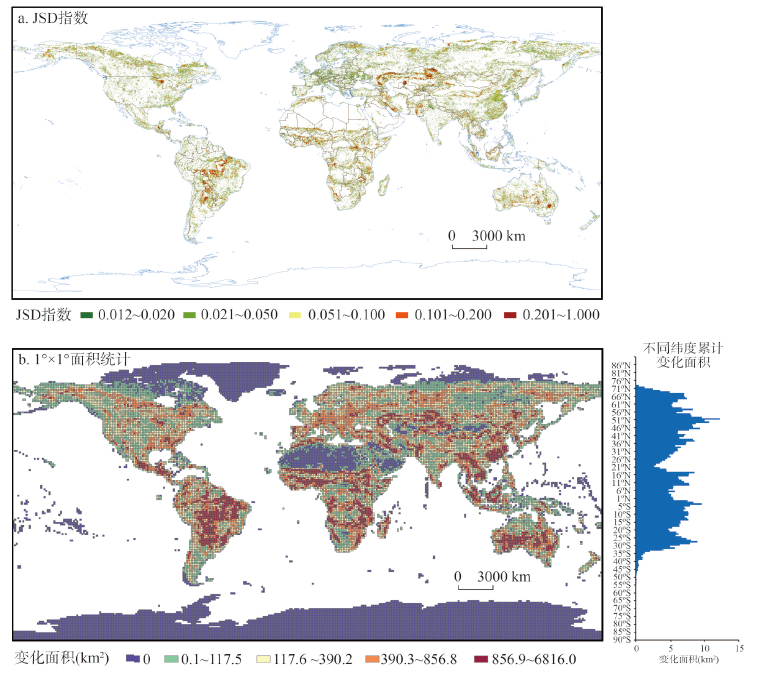

Spatio-temporal change of global land cover and China's contribution
Received date: 2020-10-27
Request revised date: 2021-11-11
Online published: 2022-04-19
Supported by
National Natural Science Foundation of China(41971207)
The Second Tibetan Plateau Scientific Expedition and Research Program(2019QZKK1005)
Copyright
In recent decades, the global land cover has undergone drastic changes, and the impact of human activities on land cover change has become one of the most significant features of the "Anthropocene". The core tasks of coping with global "unprecedented changes in a hundred years" for China in the field of sustainable development is to scientifically assess the spatio-temporal process and new trends of global land cover change, analyze China's role and status in it, and propose optimal paths. We used geospatial analysis method and multi-source land cover data to explore the spatio-temporal process of global land cover change, analyze the transformation relationship between land types and the change trend of global "greening" and forest cover, and reveal the new characteristics and trends of land cover change in China. The results showed that the global land cover experienced significant changes from 1992 to 2015, and several hot spots formed, including central South America, sub-Saharan Africa, Central Asia, Southeast Asia and East Asia. China's forest coverage rate increased from 12.98% in 1990 to 23.34% in 2020, and the wetland area increased by 1908 km2, which contributed to the maintenance of global ecological security. The interactive conversion between cultivated land and forest is the most important land cover conversion relationship in the world. In terms of cultivated land occupied by urban land, China ranks first in the world, with an area of 73000 km2. The global leaf area index presented a global trend of significant increase from 1999 to 2019. With only 6.6% of the world's vegetation area, China contributed about 20% of the global increase in leaf area index and dominated the global "greening" process. The change of global forest coverage presents remarkably spatial agglomeration. China's forest area increased by 62.8376 million hectares (1990-2020), leading the world in forest restoration. The southwest China forest region and the Qinling-Daba mountains are the main areas of forest growth, and the Yangtze River Delta, the Guangdong-Hong Kong-Macao Greater Bay Area and parts of eastern Inner Mongolia are the main areas of deforestation. In the future, China should further enhance the balance and coordination between socioeconomic development and ecological protection, continue to promote the building of a beautiful China, and contribute more strengths and experiences to global ecological security and sustainable development.

Key words: land cover change; leaf area index; forest; global; China
LI Guangdong . Spatio-temporal change of global land cover and China's contribution[J]. Acta Geographica Sinica, 2022 , 77(2) : 353 -368 . DOI: 10.11821/dlxb202202006
表2 全球与中国土地覆被面积变化综合对比Tab. 2 Comprehensive comparison of global and China's land cover area changes |
| 土地覆被面积及变化(万km2) | 耕地 | 草地 | 湿地 | 城市用地 | 其他用地 | |
|---|---|---|---|---|---|---|
| 全球 | 1992年 | 2508.79 | 1368.59 | 203.67 | 34.74 | 6118.10 |
| 2015年 | 2590.93 | 1379.25 | 190.55 | 74.08 | 6049.39 | |
| 1992—2015年净变化量 | 82.14 | 10.66 | -13.12 | 39.33 | -68.70 | |
| 中国 | 1992年 | 271.83 | 265.97 | 3.14 | 3.52 | 220.56 |
| 2015年 | 273.96 | 264.88 | 3.33 | 12.52 | 211.86 | |
| 1992—2015年净变化量 | 2.13 | -1.09 | 0.19 | 9.00 | -8.70 | |
| 中国变化量占全球比例(%) | 2.59 | - | - | 22.87 | 12.66 | |
| [1] |
|
| [2] |
|
| [3] |
|
| [4] |
|
| [5] |
|
| [6] |
|
| [7] |
|
| [8] |
|
| [9] |
|
| [10] |
ESA. CCI-LC Product User Guide version 2. http://maps.elie.ucl.ac.be/CCI/viewer/download/ESACCI-LC-Ph2-PUGv2_2.0.pdf. 2017.
|
| [11] |
|
| [12] |
|
| [13] |
|
| [14] |
|
| [15] |
|
| [16] |
|
| [17] |
|
| [18] |
|
| [19] |
|
| [20] |
[ 刘纪远, 宁佳, 匡文慧, 等. 2010—2015年中国土地利用变化的时空格局与新特征. 地理学报, 2018, 73(5): 789-802.]
|
| [21] |
[ 马恩朴, 蔡建明, 林静, 等. 远程耦合视角下的土地利用/覆被变化解释. 地理学报, 2019, 74(3): 421-431.]
|
| [22] |
[ 刘纪远, 匡文慧, 张增祥, 等. 20世纪80年代末以来中国土地利用变化的基本特征与空间格局. 地理学报, 2014, 69(1): 3-14.]
|
| [23] |
|
/
| 〈 |
|
〉 |